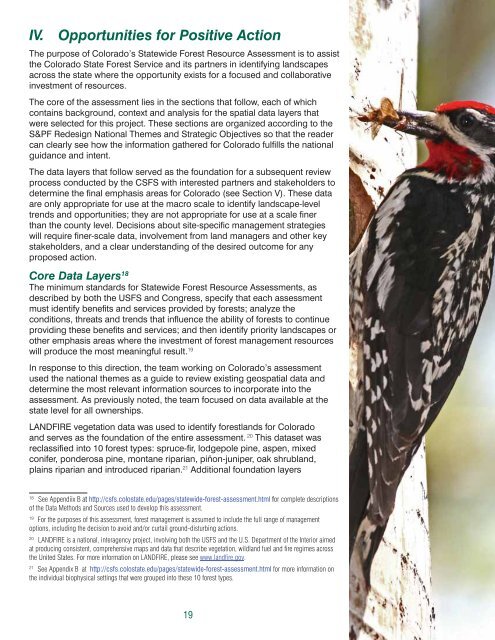Colorado Statewide Forest Resource Assessment
Colorado Statewide Forest Resource Assessment
Colorado Statewide Forest Resource Assessment
You also want an ePaper? Increase the reach of your titles
YUMPU automatically turns print PDFs into web optimized ePapers that Google loves.
IV. Opportunities for Positive ActionThe purpose of <strong>Colorado</strong>’s <strong>Statewide</strong> <strong>Forest</strong> <strong>Resource</strong> <strong>Assessment</strong> is to assistthe <strong>Colorado</strong> State <strong>Forest</strong> Service and its partners in identifying landscapesacross the state where the opportunity exists for a focused and collaborativeinvestment of resources.The core of the assessment lies in the sections that follow, each of whichcontains background, context and analysis for the spatial data layers thatwere selected for this project. These sections are organized according to theS&PF Redesign National Themes and Strategic Objectives so that the readercan clearly see how the information gathered for <strong>Colorado</strong> fulfi lls the nationalguidance and intent.The data layers that follow served as the foundation for a subsequent reviewprocess conducted by the CSFS with interested partners and stakeholders todetermine the fi nal emphasis areas for <strong>Colorado</strong> (see Section V). These dataare only appropriate for use at the macro scale to identify landscape-leveltrends and opportunities; they are not appropriate for use at a scale fi nerthan the county level. Decisions about site-specifi c management strategieswill require fi ner-scale data, involvement from land managers and other keystakeholders, and a clear understanding of the desired outcome for anyproposed action.Core Data Layers 18The minimum standards for <strong>Statewide</strong> <strong>Forest</strong> <strong>Resource</strong> <strong>Assessment</strong>s, asdescribed by both the USFS and Congress, specify that each assessmentmust identify benefi ts and services provided by forests; analyze theconditions, threats and trends that infl uence the ability of forests to continueproviding these benefi ts and services; and then identify priority landscapes orother emphasis areas where the investment of forest management resourceswill produce the most meaningful result. 19In response to this direction, the team working on <strong>Colorado</strong>’s assessmentused the national themes as a guide to review existing geospatial data anddetermine the most relevant information sources to incorporate into theassessment. As previously noted, the team focused on data available at thestate level for all ownerships.LANDFIRE vegetation data was used to identify forestlands for <strong>Colorado</strong>and serves as the foundation of the entire assessment. 20 This dataset wasreclassifi ed into 10 forest types: spruce-fi r, lodgepole pine, aspen, mixedconifer, ponderosa pine, montane riparian, piñon-juniper, oak shrubland,plains riparian and introduced riparian. 21 Additional foundation layers18See Appendiix B at http://csfs.colostate.edu/pages/statewide-forest-assessment.html for complete descriptionsof the Data Methods and Sources used to develop this assessment.19For the purposes of this assessment, forest management is assumed to include the full range of managementoptions, including the decision to avoid and/or curtail ground-disturbing actions.20LANDFIRE is a national, interagency project, involving both the USFS and the U.S. Department of the Interior aimedat producing consistent, comprehensive maps and data that describe vegetation, wildland fuel and fire regimes acrossthe United States. For more information on LANDFIRE, please see www.landfire.gov.21See Appendix B at http://csfs.colostate.edu/pages/statewide-forest-assessment.html for more information onthe individual biophysical settings that were grouped into these 10 forest types.19
















